 Researchers invented a unique way for different types of quantum technology to 'talk' to each other using sound. The study provides a step towards bringing quantum technology closer to reality.
Researchers invented a unique way for different types of quantum technology to 'talk' to each other using sound. The study provides a step towards bringing quantum technology closer to reality.
Monday, December 30, 2019
Soundwaves carry information between quantum systems
 Researchers invented a unique way for different types of quantum technology to 'talk' to each other using sound. The study provides a step towards bringing quantum technology closer to reality.
Researchers invented a unique way for different types of quantum technology to 'talk' to each other using sound. The study provides a step towards bringing quantum technology closer to reality.
Scientists create tiny lasers from nanoparticles and plastic beads
 Researchers found a way to create lasers smaller than red blood cells. These microlasers convert infrared light into light at higher frequencies. Made from nanoparticles, these are among the smallest, continuously emitting lasers of their kind ever reported.
Researchers found a way to create lasers smaller than red blood cells. These microlasers convert infrared light into light at higher frequencies. Made from nanoparticles, these are among the smallest, continuously emitting lasers of their kind ever reported.
Strategies to generate larger pores in metal-organic frameworks
 A new paper reviews recent methodology advances of hierarchically porous MOF synthesis.
A new paper reviews recent methodology advances of hierarchically porous MOF synthesis.
Sunday, December 29, 2019
Scientists develop ceramic materials that are IR-transparent
 Researchers have developed nanocomposite ceramics with uniform distribution of two phases, microhardness over 11 GPa, and average grain size of 250 nm. It capable of transmitting over 70% of IR-range with wavelength up to 6,000 nm.
Researchers have developed nanocomposite ceramics with uniform distribution of two phases, microhardness over 11 GPa, and average grain size of 250 nm. It capable of transmitting over 70% of IR-range with wavelength up to 6,000 nm.
Paving the way for spintronic RAMs: A deeper look into a powerful spin phenomenon
 Scientists explore a new material combination that sets the stage for magnetic random access memories, which rely on spin - an intrinsic property of electrons - and could outperform current storage devices. Their breakthrough published in a new study describes a novel strategy to exploit spin-related phenomena in topological materials.
Scientists explore a new material combination that sets the stage for magnetic random access memories, which rely on spin - an intrinsic property of electrons - and could outperform current storage devices. Their breakthrough published in a new study describes a novel strategy to exploit spin-related phenomena in topological materials.
Thursday, December 26, 2019
A fast and inexpensive nanotube device to capture and identify viruses
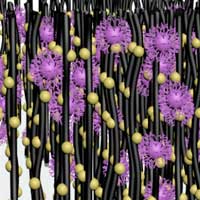 Researchers synthesized a gradient of aligned carbon nanotube forest arrays to capture different viruses according to their size and detect them in-situ using Raman spectroscopy. They designed and assembled a portable platform that enriches virus particles from several milliliters of clinical samples in a couple of minutes.
Researchers synthesized a gradient of aligned carbon nanotube forest arrays to capture different viruses according to their size and detect them in-situ using Raman spectroscopy. They designed and assembled a portable platform that enriches virus particles from several milliliters of clinical samples in a couple of minutes.
Nanowire device splits and recombines superconducting electron pairs
 A nanowire device could help explore a form of superconductivity that features exotic particles with potential uses in quantum computing.
A nanowire device could help explore a form of superconductivity that features exotic particles with potential uses in quantum computing.
Brain-like functions emerging in a metallic nanowire network
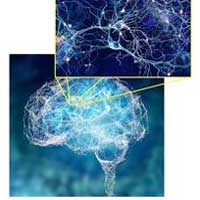 Emerging fluctuation-based functionalities are expected to open a way to novel memory device technology.
Emerging fluctuation-based functionalities are expected to open a way to novel memory device technology.
Surface acoustic waves in graphene: straintronics with nanoquakes
 Researchers have shown that the properties of graphene can be locally and dynamically modulated by means of a surface acoustic wave, a kind of earthquake on a chip, generated with an integrated transducer on a piezoelectric substrate holding the graphene sheet.
Researchers have shown that the properties of graphene can be locally and dynamically modulated by means of a surface acoustic wave, a kind of earthquake on a chip, generated with an integrated transducer on a piezoelectric substrate holding the graphene sheet.
Monday, December 23, 2019
High-performance anode for all-solid-state Li batteries is made of Si nanoparticles
 Large volume expansion during charging, the obstacle to using Si anodes in conventional liquid electrolytes, helps a Si anode composed of nanoparticles in solid electrolytes has high-rate discharge capability approaching those of Si films.
Large volume expansion during charging, the obstacle to using Si anodes in conventional liquid electrolytes, helps a Si anode composed of nanoparticles in solid electrolytes has high-rate discharge capability approaching those of Si films.
Microsensor implants for 24/7 health monitoring
 Researchers have developed a new wireless reader that is so sensitive to minute changes in a sensor's readings that it enables the creation of sub-millimetre microsensors, tiny enough to be injected under the skin.
Researchers have developed a new wireless reader that is so sensitive to minute changes in a sensor's readings that it enables the creation of sub-millimetre microsensors, tiny enough to be injected under the skin.
Researchers break the geometric limitations of moire pattern in graphene heterostructures
 Researchers have uncovered interesting phenomena when multiple two-dimensional materials are combined into van der Waals heterostructures (layered ?sandwiches? of different materials).
Researchers have uncovered interesting phenomena when multiple two-dimensional materials are combined into van der Waals heterostructures (layered ?sandwiches? of different materials).
Researchers to develop a theory of transients in graphene
 The research considers behavior of graphene in the moment of its transition from the state of thermal equilibrium and the process of returning to this state.
The research considers behavior of graphene in the moment of its transition from the state of thermal equilibrium and the process of returning to this state.
Scientists develop gentle, microscopic hands to study tiny, soft materials
 Handling very soft, delicate items without damaging them is hard enough with human hands, let alone doing it at the microscopic scale with laboratory instruments. Three new studies show how scientists have honed a technique for handling tiny, soft particles using precisely controlled fluid flows that act as gentle microscopic hands. The technique allows researchers to test the physical limits of these soft particles and the things made from them -- ranging from biological tissues to fabric softeners.
Handling very soft, delicate items without damaging them is hard enough with human hands, let alone doing it at the microscopic scale with laboratory instruments. Three new studies show how scientists have honed a technique for handling tiny, soft particles using precisely controlled fluid flows that act as gentle microscopic hands. The technique allows researchers to test the physical limits of these soft particles and the things made from them -- ranging from biological tissues to fabric softeners.
New rules illuminate how objects absorb and emit light
 Researchers have uncovered new rules governing how objects absorb and emit light, fine-tuning scientists' control over light and boosting research into next-generation solar and optical devices.
Researchers have uncovered new rules governing how objects absorb and emit light, fine-tuning scientists' control over light and boosting research into next-generation solar and optical devices.
Scientists create thin-films with tantalizing electronic properties
 As predicted by theorists, experiments show that barium zirconium sulfide thin films hold great promise for solar cells, LEDs.
As predicted by theorists, experiments show that barium zirconium sulfide thin films hold great promise for solar cells, LEDs.
From 3-D to 2-D and back: reversible conversion of lipid spheres into ultra-thin sheets
 Scientists have developed a technique for the reversible conversion of 3D lipid vesicles into 2D ultra-thin nanosheets. Both the stable nanosheets and the reversible 2D?3D conversion process can find various applications in the pharmaceutical, bioengineering, food, and cosmetic sciences.
Scientists have developed a technique for the reversible conversion of 3D lipid vesicles into 2D ultra-thin nanosheets. Both the stable nanosheets and the reversible 2D?3D conversion process can find various applications in the pharmaceutical, bioengineering, food, and cosmetic sciences.
Electronics at the speed of light
 A team of researchers has found a way of transporting electrons at times below the femtosecond range by manipulating them with light. This could have major implications for the future of data processing and computing.
A team of researchers has found a way of transporting electrons at times below the femtosecond range by manipulating them with light. This could have major implications for the future of data processing and computing.
Arrangement of atoms measured in silicene
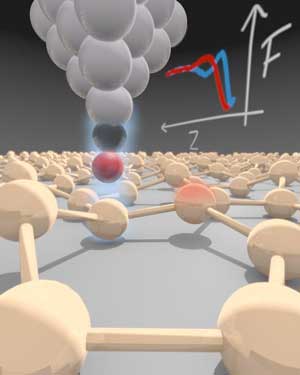 In contrast to the ultra-flat material graphene, which is made of carbon, silicene shows surface irregularities that influence its electronic properties. Now, physicists have been able to precisely determine this corrugated structure.
In contrast to the ultra-flat material graphene, which is made of carbon, silicene shows surface irregularities that influence its electronic properties. Now, physicists have been able to precisely determine this corrugated structure.
New nano-barrier for composites could strengthen spacecraft payloads
 Researchers have developed a robust multi-layed nano-barrier for ultra-lightweight and stable carbon fibre reinforced polymers that could be used to build high precision instrument structures for future space missions.
Researchers have developed a robust multi-layed nano-barrier for ultra-lightweight and stable carbon fibre reinforced polymers that could be used to build high precision instrument structures for future space missions.
Computing with molecules: A big step in molecular spintronics
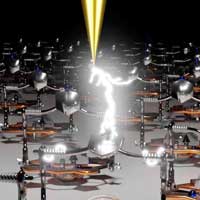 Chemists and physicists joined forces to design, deposit and operate single molecular spin switches on surfaces. The newly developed molecules feature stable spin states and do not lose their functionality upon adsorption on surfaces.
Chemists and physicists joined forces to design, deposit and operate single molecular spin switches on surfaces. The newly developed molecules feature stable spin states and do not lose their functionality upon adsorption on surfaces.
Saving Moore's Law by 3D integration with 2D materials
 By selecting certain 2D materials and stacking them, according to the researchers, not only does the monolithic 3D conserve precious space on the chip, but also allows for configuration based on the combined electronic properties of the materials.
By selecting certain 2D materials and stacking them, according to the researchers, not only does the monolithic 3D conserve precious space on the chip, but also allows for configuration based on the combined electronic properties of the materials.
Sunday, December 22, 2019
Super-resolution at all scales with active thermal detection
 Researchers have found that the temperature increase caused by the probe beam could be utilized to generate a signal per se for detecting objects. Notably, this so-called 'active thermal detection' enables super-resolution imaging at all scales, compared to conventional techniques whose application are confined to microcopy only.
Researchers have found that the temperature increase caused by the probe beam could be utilized to generate a signal per se for detecting objects. Notably, this so-called 'active thermal detection' enables super-resolution imaging at all scales, compared to conventional techniques whose application are confined to microcopy only.
Researchers realize a quantum heat engine in the lab
 A new experimental proof-of-concept quantum Otto cycle, using nuclear spins, has reached an efficiency close to its thermodynamic limit at maximum power.
A new experimental proof-of-concept quantum Otto cycle, using nuclear spins, has reached an efficiency close to its thermodynamic limit at maximum power.
Friday, December 20, 2019
Why are alloy metal nanoparticles better than monometallic ones for carbon nanotubes growth?
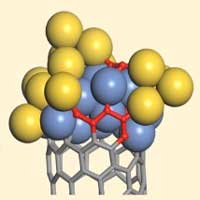 Revealing a long-term mystery of why certain nanoparticles are more efficient in incorporating carbon atoms and achieving a faster carbon nanotube growth.
Revealing a long-term mystery of why certain nanoparticles are more efficient in incorporating carbon atoms and achieving a faster carbon nanotube growth.
Thursday, December 19, 2019
Researchers directly measure 'Cheerios effect' forces for the first time
 In a finding that could be useful in designing small aquatic robots, researchers have measured the forces that cause small objects to cluster together on the surface of a liquid -- a phenomenon known as the 'Cheerios effect'.
In a finding that could be useful in designing small aquatic robots, researchers have measured the forces that cause small objects to cluster together on the surface of a liquid -- a phenomenon known as the 'Cheerios effect'.
Researchers apply temperature gradients to grow and move liquid crystals
 Researchers have discovered that applying a small difference in temperature to a watered-down mixture of a compound called zirconium phosphate initiates its liquid crystallization. As zirconium phosphate particles move toward warmer temperatures, they start aligning themselves with each other and eventually turn into pure liquid crystals.
Researchers have discovered that applying a small difference in temperature to a watered-down mixture of a compound called zirconium phosphate initiates its liquid crystallization. As zirconium phosphate particles move toward warmer temperatures, they start aligning themselves with each other and eventually turn into pure liquid crystals.
Playing the angles with dramatic effect
 Researchers develop new materials theory relevant to ultrafast electronics, batteries and more.
Researchers develop new materials theory relevant to ultrafast electronics, batteries and more.
New quantum material with intrinsically magnetic and topological properties
 An international consortium of chemists and physicists has discovered a new type of quantum material with intrinsic magnetic and topological properties. Since they manifest without doping or strong external magnetic fields, this material may lead the way to new applications in spintronics, two-dimensional magnetism and quantum transport.
An international consortium of chemists and physicists has discovered a new type of quantum material with intrinsic magnetic and topological properties. Since they manifest without doping or strong external magnetic fields, this material may lead the way to new applications in spintronics, two-dimensional magnetism and quantum transport.
Improved 3D nanoprinting technique to build nanoskyscrapers
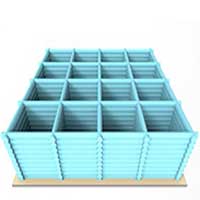 Simply adding 'table salt' helps to build self-stacked nanoarchitectures.
Simply adding 'table salt' helps to build self-stacked nanoarchitectures.
Wednesday, December 18, 2019
Nanopores can identify the amino acids in proteins, the first step to sequencing
 While DNA sequencing is a useful tool for determining what's going on in a cell or a person's body, it only tells part of the story. Protein sequencing could soon give researchers a wider window into a cell's workings. A new study demonstrates that nanopores can be used to identify all 20 amino acids in proteins, a major step toward protein sequencing.
While DNA sequencing is a useful tool for determining what's going on in a cell or a person's body, it only tells part of the story. Protein sequencing could soon give researchers a wider window into a cell's workings. A new study demonstrates that nanopores can be used to identify all 20 amino acids in proteins, a major step toward protein sequencing.
Large-area and flexible near-infrared light-emitting diodes
 Researchers have developed highly efficient, large-area and flexible near-infrared light-emitting diodes (LEDs) for new wearable device technologies.
Researchers have developed highly efficient, large-area and flexible near-infrared light-emitting diodes (LEDs) for new wearable device technologies.
Quantum-dot tattoos hold vaccination record
 Bioengineers reveal dissolving microneedles that also embed fluorescent medical info.
Bioengineers reveal dissolving microneedles that also embed fluorescent medical info.
Proof of a decades-old theory hides in the thinnest of materials
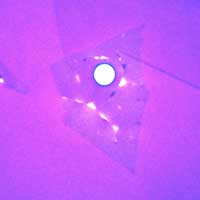 By layering two-dimensional materials, scientists have confirmed electrochemical phenomena based on theory established in the 1950s.
By layering two-dimensional materials, scientists have confirmed electrochemical phenomena based on theory established in the 1950s.
Free short story collection to entangle readers in the quantum world
 Are you ready to get entangled in the science of the very small? That's the thread running through a new anthology, Quantum Shorts: Collected Flash Fiction Inspired by Quantum Physics.
Are you ready to get entangled in the science of the very small? That's the thread running through a new anthology, Quantum Shorts: Collected Flash Fiction Inspired by Quantum Physics.
Tuesday, December 17, 2019
Turning light energy into heat to fight disease
 Scientists have developed a method involving terahertz radiation to monitor temperature changes when laser light is focused on tiny gold particles in water.
Scientists have developed a method involving terahertz radiation to monitor temperature changes when laser light is focused on tiny gold particles in water.
Chemists glimpse the fleeting 'transition state' of a reaction
 New technique for observing reaction products offers insights into the chemical mechanisms that formed them.
New technique for observing reaction products offers insights into the chemical mechanisms that formed them.
Storing data in everyday objects
 Researchers have discovered a new method for turning nearly any object into a data storage unit. This makes it possible to save extensive data in, say, shirt buttons, water bottles or even the lenses of glasses, and then retrieve it years later.
Researchers have discovered a new method for turning nearly any object into a data storage unit. This makes it possible to save extensive data in, say, shirt buttons, water bottles or even the lenses of glasses, and then retrieve it years later.
Camouflage made of quantum material could hide you from infrared cameras
 Infrared cameras detect people and other objects by the heat they emit. Now, researchers have discovered the uncanny ability of a material to hide a target by masking its telltale heat properties.
Infrared cameras detect people and other objects by the heat they emit. Now, researchers have discovered the uncanny ability of a material to hide a target by masking its telltale heat properties.
Nanocellulose-based air filter offers cost-effective low resistance
 Researchers have developed a new nanocellulose-based material that has outstanding air filtration performance.
Researchers have developed a new nanocellulose-based material that has outstanding air filtration performance.
Researchers observe brain-like behavior in nanoscale device
 'Tiny silver brains' could have long-term implications for more powerful, energy-efficient computing.
'Tiny silver brains' could have long-term implications for more powerful, energy-efficient computing.
Advanced viral nanovaccine for cancer immunotherapy
 Researchers have discovered a novel system to generate an artificially enveloped oncolytic adenovirus to direct the immune response against cancer.
Researchers have discovered a novel system to generate an artificially enveloped oncolytic adenovirus to direct the immune response against cancer.
Researchers close in on new nonvolatile memory
 Researchers have achieved a breakthrough on the way to new types of nonvolatile memory devices. The team came up with a unique method for measuring the electric potential distribution across a ferroelectric capacitor.
Researchers have achieved a breakthrough on the way to new types of nonvolatile memory devices. The team came up with a unique method for measuring the electric potential distribution across a ferroelectric capacitor.
A new gene therapy strategy, courtesy of Mother Nature
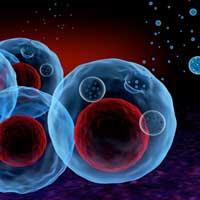 Scientists have developed a new gene-therapy technique by transforming human cells into mass producers of tiny nano-sized particles full of genetic material that has the potential to reverse disease processes.
Scientists have developed a new gene-therapy technique by transforming human cells into mass producers of tiny nano-sized particles full of genetic material that has the potential to reverse disease processes.
Liquid-like behaviour displayed but phase remains stable in ultrathin hexagonal gold nanoribbons
 Scientists have discovered that the ultrathin gold nanoribbons with unique hexagonal (4H type) crystal phase shows 'liquid-like' behaviour under heating, but its hexagonal crystalline structure remains stable. This provides insight into the thermal stability of this new type of metallic nanomaterials and facilitates the development of practical applications in the future.
Scientists have discovered that the ultrathin gold nanoribbons with unique hexagonal (4H type) crystal phase shows 'liquid-like' behaviour under heating, but its hexagonal crystalline structure remains stable. This provides insight into the thermal stability of this new type of metallic nanomaterials and facilitates the development of practical applications in the future.
The world's fastest molecular shuttle
 Thanks to a clever chemical design, researchers have succeeded in making a very fast molecular machine. The moving parts shift more than one nanometre relative to each other in a record-breaking time of 30 billionths of a second.
Thanks to a clever chemical design, researchers have succeeded in making a very fast molecular machine. The moving parts shift more than one nanometre relative to each other in a record-breaking time of 30 billionths of a second.
Monday, December 16, 2019
What happens to gold nanoparticles in cells?
 Gold nanoparticles, which are supposed to be stable in biological environments, can be degraded inside cells.
Gold nanoparticles, which are supposed to be stable in biological environments, can be degraded inside cells.
Mind the gap - new wide-bandgap topological insulator
 Researchers have discovered a 'telephone number' compound combining wide bandgap and robust topological surface state, which could enable room-temperature operation of ultra-energy efficient electronics.
Researchers have discovered a 'telephone number' compound combining wide bandgap and robust topological surface state, which could enable room-temperature operation of ultra-energy efficient electronics.
New discovery reveals tractionless motion is possible
 Sientists have answered the fundamental question: 'Is it possible to move without exerting force on the environment?', by describing the tractionless self-propulsion of active matter.
Sientists have answered the fundamental question: 'Is it possible to move without exerting force on the environment?', by describing the tractionless self-propulsion of active matter.
Artificial intelligence may help scientists make spray-on solar cells
 Artificial Intelligence may be just the thing to accelerate spray-on solar cell technology, which could revolutionize how consumers use energy. A research team used Machine Learning, aka Artificial Intelligence to optimize the materials used to make perovskite solar cells.
Artificial Intelligence may be just the thing to accelerate spray-on solar cell technology, which could revolutionize how consumers use energy. A research team used Machine Learning, aka Artificial Intelligence to optimize the materials used to make perovskite solar cells.
Subscribe to:
Posts (Atom)
